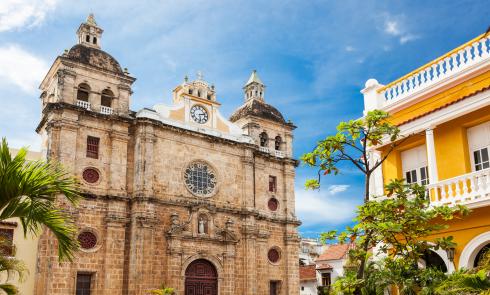- 289.813.1969
- 1.844.564.1076
- info@furtherafieldtravel.ca
You are here
Colombia

So where is Colombia? It’s a tropical equatorial country in South America. The Equator is an imaginary line drawn around the earth and recognized as 0° Latitude. The rotation of the earth, away and towards the Sun is what causes day and night.
The countries that are located on the equator have 12 hours daylight and 12 hours darkness every single day of the year, with relatively stable weather throughout the year. The climate can be diverse in many countries, but we are only dealing with South America. These countries are Colombia, Ecuador and Brazil, the Equator measures 40,000 Kilometres. The first expedition led by Magellan to circumnavigate the earth sailed from Spain in 1519 and returned in 1522 after crossing the Atlantic, the Pacific, and the Indian Oceans. The distance from the North and South Poles to the Equator is 10,000 kilometres. This is a significant measurement, as it led to the introduction of the metric system of weights and measures in 1795 by the French Parliament after their Revolution that had started in 1789. France had a complex and inconsistent system of weights and measures making trade and calculations very difficult in the marketplace. During the Age of Enlightenment the word meter was defined as one ten-millionth of the distance from the Equator to the North Pole, this was an accurate measurement, using the meridian, that line of longitude that went through Paris, France.
Looking back at the history of Colombia in particular, we are struck by Indigenous people that have called this area home for over the past 14,000 -16,000 years. The significance of their legacy is not to be ignored in the natural wonders and heritage sites left in their wake.
The beautiful city of Cartagena had its beginnings in 1533 when military defences, institutional and government buildings, churches and a cathedral were constructed. Side by side with these buildings came houses for these individuals to live in, stores for provisions and so on; in short, the foundations of a city. The city is today classed as the jewel in the Caribbean Sea. Anyone familiar with the Nobel Prize winner for literature in 1982, Gabriel Garcia Marquez will see that he used Cartagena as the source of inspiration for many of his novels and stories.
The beauty of Colombia stretches from the Pacific to the Atlantic Oceans via the Caribbean Sea. While Colombia doesn’t touch the open Atlantic directly, its Caribbean Sea coastline is part of the Atlantic Ocean system. This is unique to South America. New Granada as the region was once known in the mid-1700's comprised of Panama, Ecuador, Venezuela and present-day Colombia. Bogota is the capital city. Through struggles for independence these are now separate countries.
Visiting Colombia today, the traveller is amazed by the enormous amount of attractions, beginning with the cultural festivals, carnivals, historical sights, monuments and sculptures, floral, music, dance, art, coffee-growing, textiles and unique customs. Cuisine is engraved in their culture, a vibrant mix of flavours and ingredients, it’s a fusion of the variety of civilizations that have left their ancestral influence to create a unique culinary cuisine of stews, soups, bread, and street vendors serving pasta dishes and everything else one wants.
When touring cities throughout the world you will always find yourself inevitably dropped off at quote “one of the most beautiful Cathedrals in the world “, that may well be so but how many times have you been to an underground Cathedral constructed in a former salt mine. History, engineering, and spirituality come together in this unforgettable experience. The Andes Mountains are a spectacular sight but hidden 180 meters underground is this cathedral.
The Amazon and Choco rainforests are vital to this region for their role in climate regulations, “the lungs of the world” as they are lovingly referred too with the variety of plants, vegetation species, and wildlife, the Amazon spans several countries. The Choco on the other hand is said to be the wettest place on earth, situated on the Pacific Coast.